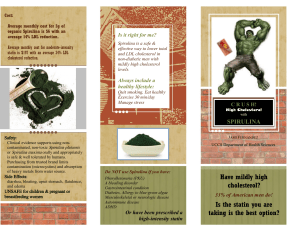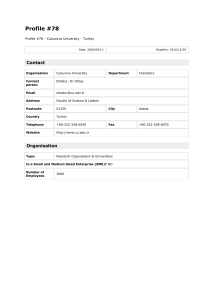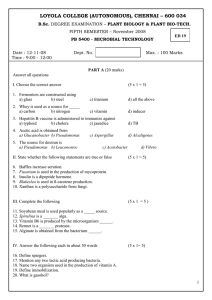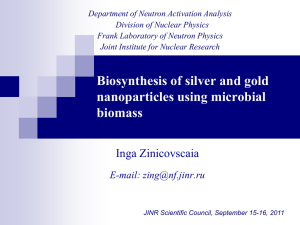Saranraj41
advertisement
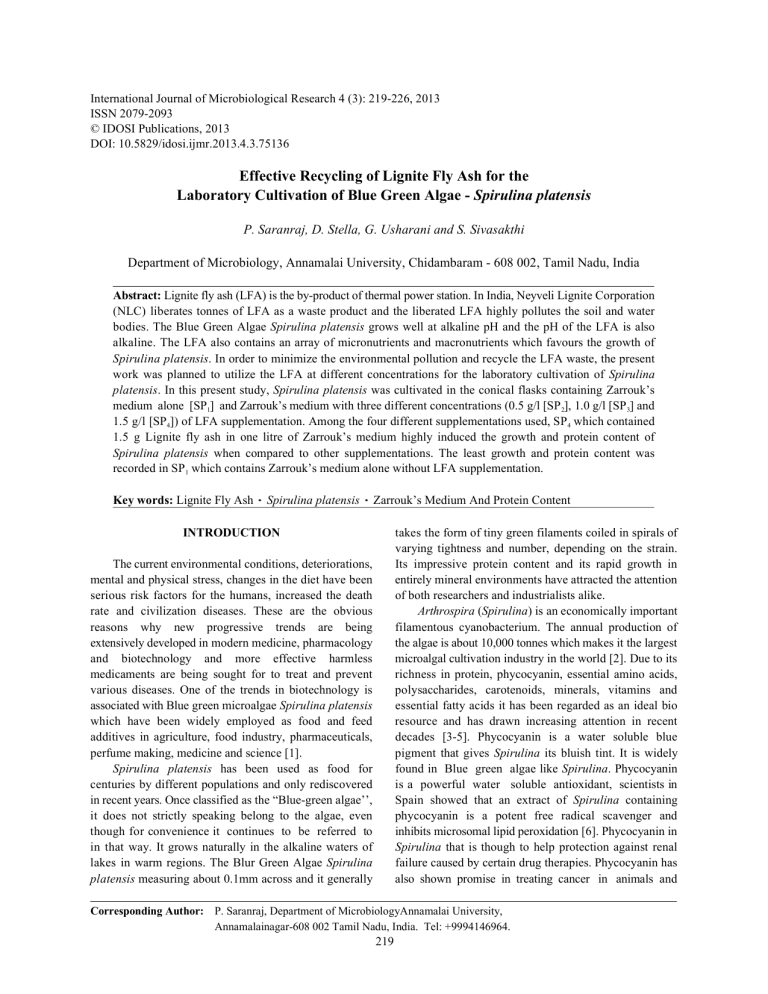
International Journal of Microbiological Research 4 (3): 219-226, 2013 ISSN 2079-2093 © IDOSI Publications, 2013 DOI: 10.5829/idosi.ijmr.2013.4.3.75136 Effective Recycling of Lignite Fly Ash for the Laboratory Cultivation of Blue Green Algae - Spirulina platensis P. Saranraj, D. Stella, G. Usharani and S. Sivasakthi Department of Microbiology, Annamalai University, Chidambaram - 608 002, Tamil Nadu, India Abstract: Lignite fly ash (LFA) is the by-product of thermal power station. In India, Neyveli Lignite Corporation (NLC) liberates tonnes of LFA as a waste product and the liberated LFA highly pollutes the soil and water bodies. The Blue Green Algae Spirulina platensis grows well at alkaline pH and the pH of the LFA is also alkaline. The LFA also contains an array of micronutrients and macronutrients which favours the growth of Spirulina platensis. In order to minimize the environmental pollution and recycle the LFA waste, the present work was planned to utilize the LFA at different concentrations for the laboratory cultivation of Spirulina platensis. In this present study, Spirulina platensis was cultivated in the conical flasks containing Zarrouk’s medium alone [SP1] and Zarrouk’s medium with three different concentrations (0.5 g/l [SP 2], 1.0 g/l [SP 3] and 1.5 g/l [SP4]) of LFA supplementation. Among the four different supplementations used, SP 4 which contained 1.5 g Lignite fly ash in one litre of Zarrouk’s medium highly induced the growth and protein content of Spirulina platensis when compared to other supplementations. The least growth and protein content was recorded in SP1 which contains Zarrouk’s medium alone without LFA supplementation. Key words: Lignite Fly Ash Spirulina platensis Zarrouk’s Medium And Protein Content INTRODUCTION takes the form of tiny green filaments coiled in spirals of varying tightness and number, depending on the strain. Its impressive protein content and its rapid growth in entirely mineral environments have attracted the attention of both researchers and industrialists alike. Arthrospira (Spirulina) is an economically important filamentous cyanobacterium. The annual production of the algae is about 10,000 tonnes which makes it the largest microalgal cultivation industry in the world [2]. Due to its richness in protein, phycocyanin, essential amino acids, polysaccharides, carotenoids, minerals, vitamins and essential fatty acids it has been regarded as an ideal bio resource and has drawn increasing attention in recent decades [3-5]. Phycocyanin is a water soluble blue pigment that gives Spirulina its bluish tint. It is widely found in Blue green algae like Spirulina. Phycocyanin is a powerful water soluble antioxidant, scientists in Spain showed that an extract of Spirulina containing phycocyanin is a potent free radical scavenger and inhibits microsomal lipid peroxidation [6]. Phycocyanin in Spirulina that is though to help protection against renal failure caused by certain drug therapies. Phycocyanin has also shown promise in treating cancer in animals and The current environmental conditions, deteriorations, mental and physical stress, changes in the diet have been serious risk factors for the humans, increased the death rate and civilization diseases. These are the obvious reasons why new progressive trends are being extensively developed in modern medicine, pharmacology and biotechnology and more effective harmless medicaments are being sought for to treat and prevent various diseases. One of the trends in biotechnology is associated with Blue green microalgae Spirulina platensis which have been widely employed as food and feed additives in agriculture, food industry, pharmaceuticals, perfume making, medicine and science [1]. Spirulina platensis has been used as food for centuries by different populations and only rediscovered in recent years. Once classified as the “Blue-green algae’’, it does not strictly speaking belong to the algae, even though for convenience it continues to be referred to in that way. It grows naturally in the alkaline waters of lakes in warm regions. The Blur Green Algae Spirulina platensis measuring about 0.1mm across and it generally Corresponding Author: P. Saranraj, Department of MicrobiologyAnnamalai University, Annamalainagar-608 002 Tamil Nadu, India. Tel: +9994146964. 219 Intl. J. Microbiol. Res., 4 (3): 219-226, 2013 stimulating the immune system [7]. A human clinical study showed that a hot water extract of Spirulina rich in phycocyanin increases interferon production and Nk cytotoxicity (cancer killing cells) when taken orally [8]. Fly ash is a waste product from thermal power stations. It has no economic use and it is a pollution hazard. Fly ash is a potentially problematic waste product after the combustion of coal in thermal power stations [9]. It is alkaline (pH 9.4) and rich in silica, aluminum, oxides of iron, calcium, magnesium, arsenic, chromium, lead, zinc, nickel and other toxic metals. Physically, fly ash is a fine, powder material with particles almost spherical in shape and excellent source of pozzolanic material. Most fly ash materials are disposed in landfills or slurry ponds. Land filling of fly ash may serve as a major source of environmental pollution through erosion and leaching of heavy metals. To prevent fly ash from being air borne, the dumping ground needs to be kept well at time. However, in India where 150 million tones fly ash is produced annually, there is an urgent need to develop methods for use of fly ash, on a small scale as well as on large scale. Each new application has to be evaluated from the environmental point of view [10]. In order to minimize the environmental pollution and recycle the Lignite fly ash waste, the present work has been planned to recycle the Lignite fly ash at different concentrations for the laboratory cultivation of Spirulina platensis. (LFA) supplementation. The Lignite fly ash (LFA) was aseptically dissolved in sterile water and filtered with filter paper. Conical flasks containing Zarrouk’s medium were added with three concentrations of Lignite fly ash (LFA) (0.5 g/l, 1.0 g/l and 1.5 g/l). SP1 - Zarrouk’s medium + Spirulina platensis SP2 - Zarrouk’s medium + 0.5g/l LFA + Spirulina platensis SP3 - Zarrouk’s medium + 1g/l LFA + Spirulina platensis SP4 - Zarrouk’s medium + 1.5g/l LFA + Spirulina platensis The conical flasks containing test medium were inoculated with 10% of mother culture of Spirulina platensis. The conical flasks were maintained under laboratory conditions and provided with light source and the medium was continuously aerated. Determination of Spirulina platensis Growth [11]: The growth of Spirulina platensis was estimated at 4 days interval for 20 days. Direct Microscopic Count: A loopful of culture was placed on a slide and a cover slip was placed over the culture. The wet mount was observed and counted under 10X objective. MATERIALS AND METHODS Optical Density: Growth performance of Spirulina platensis was monitored by optical density. Optical density was determined in a UV - Spectrophotometer. The absorption was read at 560 nm. Collection of Lignite Fly Ash (LFA): The Lignite fly ash (LFA) was collected from the Thermal power station at Neyveli Lignite Corporation (NLC) in Neyveli, Cuddalore District, Tamil Nadu. The collected Lignite fly ash sample was stored in the plastic container and stored at room temperature. Estimation of Biomass [12]: 25 ml sample of Spirulina platensis cultures were centrifuged at 5000 rpm for 10 minutes. The supernatant was discarded and sediment was oven dried (50- 60°C) and weighed. The difference was compared and the dry weight mass was calculated. In vitro Cultivation of Spirulina Platensis on Zarrouk’s Medium: The cultivation was carried out in a conical flask (1000 ml) containing Zarrouk’s medium (modified 1966). Zarrouk’s medium was prepared in sterilized distilled water and the initial pH was adjusted to 9.0. The conical flask containing the medium was inoculated with 10% of mother culture of Spirulina platensis. The conical flask was maintained under laboratory conditions and provided with light source and the medium was continuously aerated. In vitro cultivation of Spirulina platensis on Zarrouk’s medium with Lignite fly ash (LFA) supplementation: The cultivation was carried out in a conical flask (1000 ml) containing Zarrouk’s medium (modified 1966) with three different concentrations of Lignite fly ash Biomass (mg/l) = Final weight - Initial weight. Estimation of Protein Content: The protein content of Spirulina platensis cultures were estimated by the Lowry’s method [13]. Extraction of Crude Phycocyanin: Harvesting of Spirulina platensis was carried out at the end of 20th day. Harvesting was done by pouring the algal suspension on cotton cloth filter supported by beaker. The harvested slurry was washed with sterile distilled water to remove salts and bring the pH to 7.0 to 8.0. 220 Intl. J. Microbiol. Res., 4 (3): 219-226, 2013 An aliquot of twenty days old culture was used as a source for extracting phycocyanin. Harvested Biomass was homogenized in hand homogenizer for 20 minutes in presence of phosphate buffer at pH 6.8 in 1:3 ratios. The homogenized culture was subjected to freezing and thawing for 3 days. Freeze thawed sample subject to Centrifugation at 5000 rpm for 45 minutes. The supernatant raw phycocyanin was taken in sterile tubes covered with aluminium foil (To prevent light penetration) and stored at 40°C for further analysis. The crude phycocyanin concentration was calculated spectrophotometrically by measuring the absorbance at 615 nm and 652 nm using the following calculation. allophycocyanin was carried out by centrifugation of partially purified phycocyanin. After centrifugation, a pellet rich in C-phycocyanin and supernatant rich in allophycocyanin were obtained. The pellet was re suspended in phosphate buffer (pH-6.8) solution and stored at 4°C for further use. The purity of C-phycocyanin and allophycocyanin was evaluated according to the absorbance ratios, Calculation: Spirulina platensis was found in waters containing from 85 to 270 g of salt per liter, but growth seems to be optimal at salt concentrations ranging from 20 to 70 g/liter and it is possible that the population of Spirulina platensis was found at the highest salt concentrations. Spirulina can be grown in alkaline conditions and the organism appears to be capable of adaptation to very different habitats and colonizes certain environments in which life for other microorganisms is difficult. Phycocyanin is a water soluble blue pigment that gives Spirulina its bluish tint. It is found in blue green algae like Spirulina. Phycocyanin is a powerful water soluble antioxidant, scientists in Spain showed that an extract of Spirulina containing phycocyanin is a potent free radical scavenger and inhibits microsomal lipid peroxidation [16]. Lignite fly ash is the by-product of thermal power station. In Tamil Nadu, thermal power station is located in Neyveli. Neyveli Lignite Corporation (NLC) liberates tones of Lignite fly ash as a waste product and the liberated Lignite fly ash highly pollutes the soil and water bodies. The Blue Green Algae Spirulina platensis grows well at pH 9.0 and the pH of the Lignite fly ash is also alkaline. In order to minimize the environmental pollution and recycle the Lignite fly ash waste, the present work has been planned to utilize the Lignite fly ash at different concentrations for the in vitro cultivation of Spirulina platensis. From the past decades a lot of researches was conducted to recycle the wastes through Spirulina cultivation. Ciferri [17] stated that Spirulina is a ubiquitous organism. After the first isolation by Turpin in 1827 from a fresh water stream, species of Spirulina have been found in a variety of environments: soil, sand, marshes, brakish water, sea water and fresh water. The organism appears to be capable of adaptation to very Phycocyanin mg/ml = The purity of C-phycocyanin = A620/A280. The purity of allophycocyanin = A655/A280. RESULTS AND DISCUSSION A615-0.047(A652) 5.34 whereas, A615- absorbance at 615nm A652- absorbance at 652nm. 5.34 – constant factor. Partial Purification of Crude Phycocyanin by Precipitation [14]: The crude phycocyanin was centrifuged at 10,000 rpm for 10 minutes to obtain cell free extract and precipitated with 50% saturated ammonium sulphate and incubated at 4°C for overnight. The precipitate obtained was centrifuged at 12,000 rpm and dialyzed with phosphate buffer (pH-6.8). The dialyzed sample was re suspended in phosphate buffer and subjected to 35% ammonium sulphate precipitation for overnight incubation. The partially purified phycocyanin concentration was calculated spectrophotometrically by measuring the absorbance at 615 nm and 652 nm using the following calculation. Calculation: Phycocyanin mg/ml = A615-0.047(A652) 5.34 whereas, A615- absorbance at 615nm A652- absorbance at 652nm. 5.34 – constant factor. Purification of Spirulina platensis C-Phycocyanin and Allophycocyanin from Partially Purified Phycocyanin [15]: The purification of C-phycocyanin and 221 Intl. J. Microbiol. Res., 4 (3): 219-226, 2013 different habitats and colonizes certain environments in which life for other microorganisms is, if not possible, very difficult; typical is the population by alkalophylic Spirulina platensis of certain alkaline lakes in Africa and Spirulina maxima of lake Texcoco in Mexico. In this present study, the Blue Green Algae (BGA) Spirulina platensis was cultivated under laboratory condition on Zarrouk’s medium and Zarrouk’s medium with Lignite fly ash (LFA) supplementations (SP1, SP2, SP3 and SP4) for 20 days. The growth and protein content of Spirulina platensis was estimated at every 4 days interval for 20 days. The growth performance was observed by direct microscopic count, Optical density at 560 nm and Dry biomass. The protein content was estimated by Lowry’s method. The Direct microscopic count of Spirulina platensis was high in SP4 (182) followed by SP3 (154) and SP2 (136). The least microscopic count was recorded in SP1 (121) (Figure 1). The optical density of Spirulina platensis was high in SP4 (0.759) followed by SP3 (0.667) and SP2 (0.578). The least optical density was recorded in SP1 (0.331) (Figure 2). The Dry biomass of Spirulina platensis was high in SP4 (2.88 mg/l) followed by SP3 (2.76 mg/l) and SP2 (2.64 mg/l). The least Dry biomass was recorded in SP1 (2.48 mg/l) (Figure 3). The protein content of Spirulina platensis was high in SP4 (109 µg/mg) followed by SP3 (96 µg/mg) and SP2 (93 µg/mg). The least protein content was recorded in SP1 (86 µg/mg) (Figure 4). Among the four different supplementations used, SP4 which contains 1.5 g Lignite fly ash in Zarrouk’s medium highly induced the growth and protein content of Spirulina platensis when compared to other supplementations. Akter et al. [18] used the Rice husk ash (RHA) and NaHCO3 as a source of carbon in Spirulina culture. They reported that the addition of 2.0 g NaHCO3/litre every two days supported better growth of Spirulina than 1.0 g RHA/litre every day, although this might not be supported on economic ground. Raoof et al. [19] formulated a new medium for mass production of Spirulina sp. by incorporating selected nutrients of the standard Zarrouk’s medium. This newly formulated medium contains single super phosphate, sodium nitrate, muriate of potash, sodium chloride, magnesium sulphate, calcium chloride and sodium bicarbonate (commercial grade). Minkov et al. [20] investigated the growth pattern of Spirulina platensis in standard and modified media based on seawater-chemicals and seawater fertilizers. During the cultivation, the cell concentrations were analyzed at 540 nm along with protein and chlorophyll-a estimation. Growth patterns of different species and strains were monitored for 25 days and specific growth rate, mean daily division rate and doubling time were calculated. Spirulina platensis was observed to have different specific growth characteristics in different media at same environmental parameters. In this study, phycocyanin was extracted from harvested Spirulina platensis by homogenization with Sodium phosphate buffer of pH 6.8 and subjected to freezing, thawing and centrifugation. The purity of phycocyanin concentration was estimated according to Minkov et al. [21]. The crude extract of phycocyanin from the Spirulina platensis cultures (SP1, SP2, SP3 and SP4) was estimated spectrophotometrically. The concentration of crude phycocyanin was high in SP4 (0.262 mg/ml) followed by SP3 (0.237 mg/ml) and SP2 (0.169 mg/ml). The least crude phycocyanin concentration was recorded in SP1 (0.121 mg/ml) (Figure 5). The crude phycocyanin extracted from the Spirulina platensis cultures (SP1, SP2, SP3 and SP4) was partially purified by precipitation with 50% Saturated ammonium sulphate. The concentration of partially purified phycocyanin was high in SP4 (0.498 mg/ml) followed by SP3 (0.378 mg/ml) and SP2 (0.241 mg/ml). The least crude phycocyanin concentration was recorded in SP1 (0.194 mg/ml) (Figure 6). The purity of Allophycocyanin and C-phycocyanin extracted from Spirulina platensis (SP1, SP2, SP3 and SP4) was calculated. The purity of Allophycocyanin was high in SP4 (1.107 mg/ml) followed by SP3 (1.097 mg/ml) and SP2 (0.877 mg/ml). The least allophycocyanin concentration was recorded in SP1 (0.772 mg/ml) (Figure 7). The purity of C-phycocyanin was high in SP4 (1.590 mg/ml) followed by SP3 (1.410 mg/ml) and SP2 (1.364 mg/ml). The least C-phycocyanin concentration was recorded in SP1 (1.255 mg/ml) (Figure 8). Zhang [22] separated C-phycocyanin and allophycocyanin from Spirulina platensis and purified them by precipitation with ammonium sulphate, ion exchange chromatography and gel filtration chromatography. Pure C-phycocyanin and allophycocyanin were finally obtained with an A620/ A280value of 5.06 and an A655/A280 value of 5.34, respectively. 222 Intl. J. Microbiol. Res., 4 (3): 219-226, 2013 Fig. 1: Growth performance of Spirulina platensis by direct microscopic count Fig. 2: Growth performance of Spirulina platensis by Optical density at 560nm. Fig. 3: Growth performance of Spirulina platensis by dry biomass (mg/l) Fig. 4: Estimation of protein content in Spirulina platensis by Lowry’s method 223 Intl. J. Microbiol. Res., 4 (3): 219-226, 2013 Fig. 5: Concentration of Crude phycocyanin extracted from Spirulina platensis cultures Fig. 6: Concentration of Partially purified phycocyanin extracted from Spirulina platensis cultures Fig. 7: Purity of Allophycocyanin extracted from Spirulina platensis cultures Fig. 8: Purity of C-phycocyanin extracted from Spirulina platensis cultures 224 Intl. J. Microbiol. Res., 4 (3): 219-226, 2013 REFERENCES Silveira and Burkert [23] extracted C-phycocyanin from cyanobacteria Spirulina platensis which was optimized using factorial design and response surface techniques. The effects of temperature and biomasssolvent ratio on phycocyanin concentration and extract purity were evaluated to determine the optimum conditions for phycocyanin extractions. The optimum conditions for the extraction of phycocyanin from Spirulina platensis were the highest biomass-solvent ratio, 0.08g/ml/l and 250C. Under these conditions it’s possible to obtain an extract of phycocyanin with a concentration of 3.68mg.mL/1 and purity ratio (A615, A280) of 0.46. This present work clearly showed the capability of Lignite fly ash for the cultivation of Spirulina platensis. This present research improves the production of the Blue green algae Spirulina platensis and prevents the environment from the Lignite fly ash pollution. Usharani et al. [24] collected the water samples for the isolation of strains of alga Spirulina platensis from three different locations and the strain Spirulina platensis was isolated and it was, designated as ANS - 1 strain. The characteristics of Spirulina platensis ANS -1 were compared with reference CAS -10. The waste water rice mill effluent was collected and its pH was adjusted to 9-11 by using sodium bicarbonate @ 800 mg l-1 and it was used as a medium. The isolated strain ANS -1 and reference strain CAS 10 were grown in substrates 1/6 diluted Zarrouk’s medium (control) and rice mill effluent. The well performed strain CAS 10 under in vitro condition was selected as efficient one. The growth of Spirulina platensis was measured both in laboratory and outdoor condition by using the parameters viz., optical density, population, dry weight, protein and chlorophyll content. The high growth and dry weight were recorded in 1/6 diluted Zarrouk’s medium when compared to rice mill effluent medium. Maximum protein and chlorophyll content were noticed in 1/6 diluted Zarrouk’s medium than rice mill effluent. The growth of Spirulina platensis was high in Zarrouk’s medium containing 1.5 g/l Lignite fly ash. The purity of Phycocyanin concentration obtained from the supplemented culture was also higher than the control. At the same time the Lignite fly ash is the cheaper source to cultivate the Spirulina platensis. This present research improves the production of the Blue green algae Spirulina platensis in future and prevents the environmental pollution emerging from the Lignite fly ash. 1. Vonshak, A., 2007. Spirulina platensis (Arthrospira) Physiology, Cell-biology and Biotechnology, Fifth Edition, Taylor and Francis, London. ISBN: 7484-0674. 2. Zhang, X., S. Qin, J Ma and P. Xu, 2005. The genetics of marine algae. China Agriculture Press, Beijing, 464. Biotechnology Letters, 29: 459-464. 3. Moris, A., J.L. Montesinos, J.A Cusido and F. Godia, 2001. Recovery and treatment of Spirulina platensis cells cultured in a continuous photobioreactor to be used as food. Process Biochemistry, 37: 535-547. 4. Kawata, Y., K.S.H Yano and M. Toyomizu, 2004. Transformation of Spirulina platensis strain C1 (Arthrospira sp.) with Tn5 Transposase Transposon DNA Cation Liposome Complex. Marine Biotechnology, 6: 355-363. 5. Chen, T., W. Zheng, G.F Yang, Y Bai and Y. Wong, 2006. Mixotrophic culture of high selenium enriched Spirulina platensis on acetate and the enhanced production of photosynthetic pigments. Enzyme Microbial Technology, l39: 103-107. 6. Pinero, M., K.H Baasch and P. Pohl, 2001. Biomass production total protein, chlorophyll, lipids and fatty acids of fresh water green and blue - green algae under different nitrogen regimes. Phytochemistry, 23: 207-216. 7. Iijima, N., S Jensen and G. Knutsen, 2011. Influence of light and temperature on photoinibition of photosynthesis in Spirulina platensis. Journal of Applied Phycology, 5: 495-504. 8. Hirahashi, B.L., S Sato and E. Aguarone, 2010. Influence of the nutritional sources on the growth rate of Cyanobacteria. Arquivos-de-BiologiaTechnologia, 34: 13-30. 9. Usharani, G., P. Saranraj and D. Kanchana. 2012. Spirulina Cultivation: A Review. International Journal of Pharmaceutical and Biological Archives, 3(6): 1327-1341. 10. Gupta, S.K., A. Tewari, R. Srivastava, R.C. Murthy and S. Chandra, 2005. Potential of Eisenia fetida for sustainable and efficient vermicomposting of fly ash. Water, Air and Soil Pollution, 163: 293-302. 11. Tolga G., Ksan Zekeruyaoulu and A.K. Ulknur, 2007. The growth of Spirulina platensis in different culture systems under greenhouse condition. Turkey Journal of Biology, 31: 47-52. 225 Intl. J. Microbiol. Res., 4 (3): 219-226, 2013 12. Venkataraman, L.V., 1983. A monocraph on Spirulina platensis biotechnology and application. Dept of science and technology, India and the Indo-German algal project CFTRI , Mysore, pp: 100. 13. Lowry, O.H., N.J. Rosebrough, A.L. Farr and R.J. Randall, 1951. Protein measurement with the folin phenol reagent. Journal of Biological Chemistry, 193: 267-275. 14. Craig. I.W., M. Chen and N.G. Carr, 1996. C-Phycocyanin and Allophycocyanin in Two Species of Blue-Green Algae. Biochemistry Journal, pp: 106-361. 15. Narayan, A.V. and Raghavarao, 2007. Extraction and purification of C-Phycocyanin from Spirulina platensis employing aqueous two phase systems. International Journal of Food Engineering, 3(4): 16. 16. Pinero, M., K.H. Baasch and P. Pohl, 2001. Biomass production total protein, chlorophyll, lipids and fatty acids of fresh water green and blue - green algae under different nitrogen regimes, Phytochemistry, 23: 207-216. 17. Orio Cifferi, 1983. Spirulina, the Edible Microorganism. Microbiological Reviews, 47: 551-578. 18. Akter, N., P. Noor, M.A.A. Jahan and M.M. Hossain, 1996. Spirulina culture in Bangladesh. V. Comparison of rice husk ash and sodium bicarbonate as source of carbon feed back in Spirulina culture, Bangladesh Journal of Science and Industrial Res., 31: 137-146. 19. Roof, B., A. Zeker and Knur, 2006. The Growth of Spirulina platensis in Different Culture Systems Under Greenhouse Condition. Turkey Journal of Biology, 31: 47-52. 20. Bohra, F., 2009. Role of light and photosynthesis on the acclimation process of the cyanobacterium Spirulina platensis to salinity stress. Chemosphere, 7(120): 227-236. 21. Minkov, B., B.D. Kaushika and R. Prasanna, 2003. Formulation of a low-cost medium for mass production of Spirulina. Division of Microbiology, Indian Agricultural Research Institute, New Delhi 110 012, India and the Centre for Conservation and Utilization of Blue–Green Algae, Indian Agricultural Research Institute, New Delhi, 110 012, India. 22. Zhang, Y.M., 2004. A simple method for efficient separation and purification of C-Phycocyanin and allophycocyanin from Spirulina platensis. Biotechnology Techniques, 13: 601-603. 23. Silveira, S.T., J.F.M. Burkert, J.A.V. Costa, C.A.V. Burkert and S.J. Kalil, 2007. Optimization of phycocyanin extraction from Spirulina platensis using factorial design, Bioresource Technology, 98: 1629-1634. 24. Usharani, G., P. Saranraj and D. Kanchana, 2012. In vitro cultivation of Spirulina platensis using Rice mill effluent. International Journal of Pharmaceutical and Biological Archives, 3(6): 1518-1523. 226


